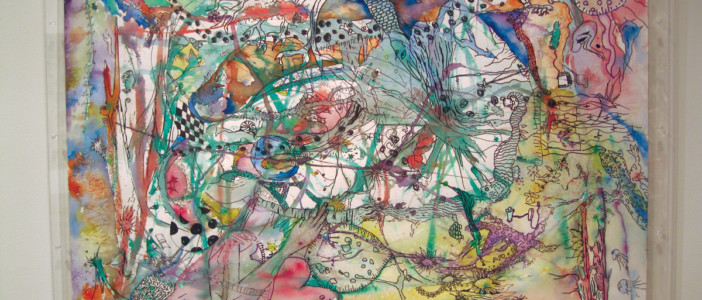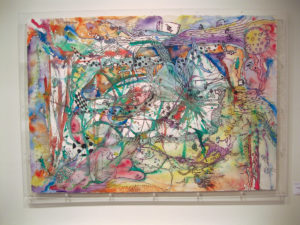
The Dialogue by Dietrich and Kemlyn Tan Bappe– A Dueling Drawing
By Renee Van Roekel '14
ART 110: Ancient Art History
Learning effective ways to put visual ideas into words is one of the most challenging aspects of studying Art History. The difficulty lies in the way that the colors and forms we see with our eyes communicate more than just material things; they evoke mood and memory and a host of other intangible experiences that don’t always translate readily into written words. When a writer adeptly describes a work of art and at the same time manages to summon for the reader these intangible qualities, she contributes whole new wonders for the reader and viewer to ponder. Renee’s essay does just that: her eloquent description not only guides us in discovering meaning from the complex physical composition of lines and colors in the picture but also prompts us to reflect on the sensations these forms generate in the viewer’s mind.
-Susan Swanson
Normally, people consider dialogue to be between two people. The English Oxford Dictionary defines dialogue as “a discussion between two or more people or groups, especially one directed toward exploration of a particular subject or resolution of a problem.” The painting entitled, The Dialogue, offers a complex perspective of what dialogue within our ecosystem could look like. Imagine an artist who wants to show life as a complex process where all things are inter-connected. Humans co-exist with creatures, which co-exist with the sea, which subsist with all creatures and organisms of the world, and so forth. The artist of The Dialogue blended a busy scene of life with the contrast of pastel colors and sharp ink lines for an interpretation of an ecosystem with a dialogue of its own.
At first glance, the larger and less abstract images stand out—a human arm with a hand, a lizard, and various forms of sea life. However, the mere busyness of the colorful painting cannot be ignored because it contributes to a sense of visual chaos the viewer feels. Looking carefully at the different images within the big picture help the viewer to interpret the dialogue the artist may have wanted to convey. Within the painting are hearts, a cat, a turtle, a face with eyes, nose, and a mouth, tea cups, sting rays, crabs, jelly fishes, an electronic lamp with plug in, a ladybug, birds, plant life, a shark, snails, an Eiffel tower replica, a windmill, as a source of energy, mountains, a spider web, a skull, and various images of humans. There is no distinguishable foreground or background, but an even display of images integrated together. At the top of the painting floats a can, reflecting a concern for the environment due to litter and other ways that humans harm or interrupt the natural earth. With so many visuals on a small scale, the viewer is overwhelmed by the amount of images in close proximity, leaving little space all together and calling for an attention to detail. The formal elements of color and line are used dramatically to draw the busy scene together, creating chaos and excitement.
The materials of the dueling drawing are watercolor paint and ink on paper. The total composition evokes a message of co-existence and perhaps a concern for the ecosystem. The artwork is complex, and contains a lot of detail in a small amount of space. The pastel watercolors give a lively and colorful vibe to the picture. The colors are mostly secondary and of a lower saturated quality. Because watercolor paints have a way of blending and running together, more freedom and less rigidity is given to the art and its colors. The black ink is a sharp contrast to the soft pastels. Ink is more precise and gives the artist control back, helping to define details and place images, while letting the color do its work by bleeding and merging together on the canvas. The artist’s use of ink gives the painting one of its important qualities of continuous black lines, which breaks up the busy painting.
Line work is a major component of The Dialogue and an element of the overall composition that allows us to interpret the dialogue conveyed in the art. Since sharp lines are not formed from watercolor painting, the ink serves as a way to define lines of the forms. The sharp lines from the ink, for example, cause the large human forearm and hand to stand out in the corner of the painting. Although the lines break up to create different images, there is also apparent use of continuous lines in the painting. Some of them seem to have no distinguishable beginning or end, and many split off in different directions, adding to the drawing’s complexity.
Although sea life is one of the more major themes, several discernible images of humans complete the circle of life. Some of the forms are of people in a fetal position; they look like they are curled up or sleeping. Others look like they are leaping or dancing—signs of vitality or movement. The presences of human figures in the painting suggest an interpretation of human effects on the ecosystem and environment. The artist may be reflecting on mankind’s overall role in the ecosystem and the dialogue that naturally exists between organisms. The painting is unified by its common themes of ocean, earth, and the natural life, life that has been interrupted. Imagine the dialogue of the ocean, the creatures of water and land, and of people and organisms. It is not a simple communication. The dialogue of the ecosystem is complex, busy, and above all—conflicted.

The Dialogue – By: Dietrich and Kemlyn Tan Bappe